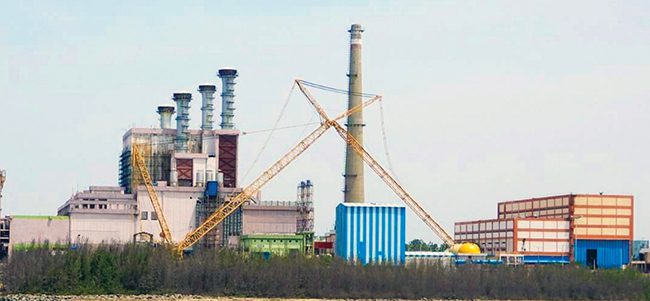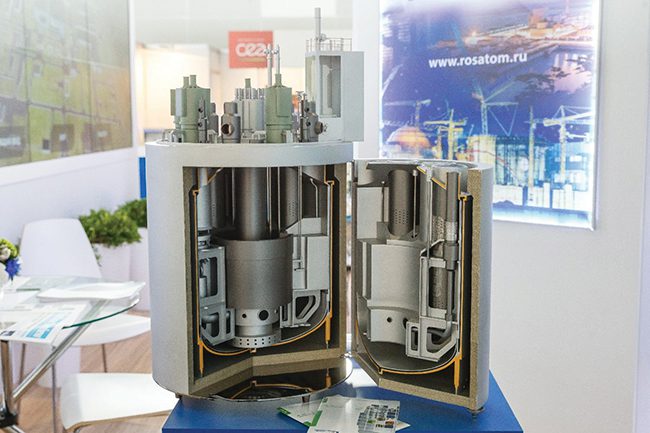Long-Awaited Milestone: Fuel Loading Begins at India's Prototype Fast Nuclear Reactor
India in March began fuel loading at a 500-MWe/1,250-MWth prototype fast-breeder reactor (PFBR) located at Kalpakkam, Tamil Nadu, marking a crucial phase for the second stage of the country’s ambitious three-stage nuclear program.
 |
|
1. Fuel loading began in March 2024 at India’s 500-MWe/1,250-MWth prototype fast-breeder reactor (PFBR) located at Kalpakkam, Tamil Nadu. Courtesy: Bharatiya Nabhikiya Vidyut Nigam Ltd. |
Fuel loading at the domestically developed PFBR site (Figure 1) adjacent to the Madras Atomic Power Station was witnessed by Prime Minister Narendra Modi on March 4. “Upon completion of the core loading, the first approach to criticality will be achieved, leading to the generation of power subsequently,” the Prime Minister’s Office said in a statement. Once commissioned, India will be one of only a handful of countries with an operating commercial fast-breeder reactor (FBR).
A Flagship Project of India’s Ambitious Three-Pronged Nuclear Strategy
The sodium-cooled, mixed oxide–fueled, pool-type fast reactor project was designed by India’s Indira Gandhi Centre for Atomic Research (IGCAR) based on the success of IGCAR’s 13.6-MWe/40-MWth fast breeder test reactor (FBTR), an experimental sodium-cooled fast reactor that has operated since 1985 using a fuel mix of plutonium carbide and uranium carbide. The 500-MW PFBR got its start in October 2003, when the Indian government set up a wholly owned enterprise, Bharatiya Nabhikiya Vidyut Nigam Ltd. (BHAVINI), and tasked it with the construction, commissioning, and operation of the project. Construction of the reactor began in 2004.
For India, the PFBR is an integral part of its three-pronged nuclear program, which was developed largely by renowned Indian physicist Homi Bhabha during the country’s almost 30-year-long isolation from international nuclear trade that began in the late 1960s.
Excluded from the Nuclear Non-Proliferation Treaty and subject to a 1974 trade embargo for acquiring nuclear weapons capability, the country embarked on the program that champions self-reliance through the development of domestic technology that reduces its reliance on imported uranium and strives to make more substantial use of thorium, of which India has more abundant reserves. The program envisions a phased approach that utilizes all three main fissionable materials: uranium-235, plutonium, and uranium-233 (U-233).
As POWER has reported, the first step of the three-stage program involves building indigenously engineered pressurized heavy-water reactors (PHWRs) and light-water reactors (LWRs) to produce plutonium. The second stage utilizes fast-neutron reactors fueled by plutonium to breed U-233 from thorium. In the third stage, using wholly indigenous technology, including its fast reactors, the country will use advanced heavy-water reactors fueled with U-233 obtained from the irradiation of thorium in PHWRs and fast reactors.
Commercial operation of the 500-MW PFBR at Kalpakkam will mean India has attained the program’s second stage. The third stage envisions an advanced heavy-water reactor (AHWR) and accelerator-driven system (ADS).
PFBR Will Initially Use MOX
While India kicked off the construction of the PFBR project 20 years ago, the project has gained significant new emphasis under Atmanirbhar Bharat, a 2020-founded policy that upholds self-reliance. Because FBRs typically have a high regeneration factor, they can produce more potential fuel than they consume and burn out highly active transuranic elements (actinides), the government noted in March. “Since it uses the spent fuel from the first stage, FBR also offers a great advantage in terms of a significant reduction in nuclear waste generated, thereby avoiding the need for large geological disposal facilities,” it said.
The PFBR at Kalpakkam will initially use uranium-plutonium mixed oxide fuel (MOX). “The uranium-238 ‘blanket’ surrounding the fuel core will undergo nuclear transmutation to produce more fuel, thus earning the name ‘breeder,’ ” the prime minister’s office noted in March. “The use of thorium-232, which in itself is not a fissile material, as a blanket is also envisaged in this stage. Thorium will create fissile U-233 by transmutation, which will be used as fuel in the third stage.” The FBR is “thus a steppingstone for the third stage of the program, paving the way for the eventual full utilization of India’s abundant thorium reserves,” it said.
According to the Bhabha Atomic Research Centre, the three-pronged strategy has grown more significant considering the country’s meager uranium but abundant thorium reserves. “The country has nuclear ores from which a total of about 78,000 tonnes of uranium metal and about 518,000 tonnes of thorium metal can be extracted,” it said. “If all uranium resources are first used in natural uranium–fueled PHWRs, it is estimated that about 420 [gigawatt-years (GWe-yrs)] of electricity can be produced. The resulting depleted uranium and separated plutonium from these PHWRs, if used in fast breeder reactors (FBRs), could generate an additional 54,000 GWe-yrs of electricity,” it said. “In these FBRs, production of U-233 can also be achieved by loading thorium assemblies in their blanket and low-power zones. Eventually, by transitioning to generations of Th-U233-fueled breeder reactors, India should be able to produce an additional 358,000 GWe-yrs of electricity.”
Government sources suggest fuel for the PFBR was custom fabricated under the supervision of the Nuclear Recycle Board. Modi in January dedicated the Demonstration Fast Reactor Fuel Reprocessing Plant, a $48 million facility at IGCAR in Kalpakkam. The facility “is the only of its kind in the world and is capable of reprocessing both carbide and oxide fuels discharged from the fast reactors,” the government said.
Last year, the PFBR completed major activities, including integrated leak rate testing of the reactor containment and independent verification and validations of systems that require sodium filling in the main vessel. These aspects are critical for safe operation, given that leaks in sodium systems can be exceptionally hazardous. The PFBR comprises a primary sodium circuit, secondary sodium circuits, safety-grade heat removal circuits, and a steam-water circuit. All sodium pipelines inside the reactor containment building (RCB) are double-walled and provided with a hot guard pipe, BHAVINI has noted.
A Potential New Boost for Fast Reactor Technology
FBRs—specifically, Argonne National Laboratory’s Experimental Breeder Reactor I (EBR I) in Idaho—kicked off the nuclear power age in 1951. But despite countless breakthroughs, fast-neutron reactors have remained commercially elusive. Only about 20 fast reactors have operated, some since the 1950s, and only one has operated in a commercial capacity—France’s 1,250-MWe commercial prototype Superphenix, which ran from 1985 to 1998, when it was closed on political grounds.
At the end of 2016, Russia put online the 800-MWe (2,100-MWth) BN-800 at its Beloyarsk nuclear plant, a sodium-cooled fast reactor project that POWER recognized as a pioneering Top Plant in 2016. The BN-800 reactor was, for the first time, fully loaded with uranium-plutonium MOX fuel in 2022. In December 2023, it was preparing to begin pilot operation loaded with fuel assemblies holding a fuel matrix comprising plutonium as well as other transuranic elements—americium-241 and neptunium-237.
 |
|
2. Rosatom’s BN-1200M is a recently unveiled 1,200-MWe/2,800-MWth sodium-cooled unit that will contribute to closing Russia’s nuclear fuel cycle. It has a four-loop design with a symmetric layout of the loops. The first deployment is planned at Beloyarsk Unit 5 by 2031. Courtesy: Rosatom |
Rosatom has said, however, that the plant’s primary purpose is experimental—to “refine the fast breeder technology, which will eventually be used to close the nuclear fuel cycle.” Nuclear engineering company OKBM Afrikantov is currently developing BN‑1200M, a 1.2-GWe/2.8-GWth sodium-cooled reactor, to be installed at Beloyarsk Unit 5 (Figure 2).
Rosatom, in tandem, has kicked off construction of the 300-MWe/700-MWth lead-cooled BREST-OD-300 fast reactor at TVEL’s Siberian Chemical Combine in Seversk. “This is the world’s first new generation lead-cooled fast reactor,” Rosatom noted in January.
“The BREST-OD-300 reactor will provide itself with its main energy component—plutonium-239—reproducing it from the isotope uranium-238, which has a relative abundance of more than 99% (it is the isotope uranium-235, which makes about 0.7% of natural uranium, that is currently used to produce energy in thermal reactors). The introduction of such technologies will increase exponentially the efficiency of natural uranium,” it said in January.
According to the World Nuclear Association, several other fast-neutron designs are readying for near- to mid-term deployment. In the U.S., that includes Natrium, a federal demonstration project. Canada’s NB Power is gearing up to demonstrate an ARC-100, 100-MWe/286-MWth sodium-cooled reactor. Several other smaller projects are underway. Oklo has plans to build its second and third commercial 15-MWe Aurora Powerhouse reactors, a vertically oriented compact passive fast-spectrum design, in Ohio.
In Europe, projects include ALFRED, a 300-MWth lead-cooled demonstration led by Belgium, Italy, and Romania. Ansaldo and Westinghouse are now advancing a related design. China, which has operated a sodium-cooled 20-MWe CEFR (China Experimental Fast Reactor) since 2010, is reportedly making progress in building a 600-MWe sodium-cooled demonstration (CDFR-600). Some reports suggest operation of the unit has begun. Now, China is planning a larger commercial 1.2-GWe fast reactor (CDFR-1000). Meanwhile, Japan’s efforts are centered on its 500-MWe sodium-cooled JSFR (Japan Sodium-cooled Fast Reactor).
Project Has Suffered Lengthy Delays
The PFBR’s fuel loading milestone is especially relevant in this context. Still, it remains unclear when commissioning is expected. The project, originally anticipated to take eight years to complete, has suffered notable delays. According to the Chennai-based IAS Parliament and other media reports, the delays stemmed from funding deficits, procurement delays, operational challenges, technical difficulties, and the geopolitical impact of the Fukushima accident.
The Ministry of Statistics and Programme Implementation has reportedly suggested the project’s costs more than doubled from INR 34.9 billion ($422 million) to INR 77 billion ($931 million) as of May 2023. However, POWER could not verify that figure. Still, the Prime Minister’s Office remains optimistic. “Notably, despite the advanced technology involved, both the capital cost and the per unit electricity cost are comparable to other nuclear and conventional power plants,” it said.
Along with new milestones for the PFBR, India has marked notable milestones for its nuclear fleet. The country has a 7.5-GW nuclear fleet of 18 PHWR units and two Russian-designed VVER pressurized water reactors (PWRs, at Kundankulam in Tamil Nadu). Two boiling water reactors (BWRs) at Tarapur Atomic Power Station in Maharashtra state and one PHWR (Unit 1 at the Madras Atomic Power Station in Tamil Nadu) are currently suspended.
In September, India began commercial operation of its first domestically designed 700-MWe PHWR at Kakrapar 3 in Gujarat. Unit 4, a twin 700-MWe unit, achieved criticality in December and was grid-connected in February. State-owned Nuclear Power Corp. of India Ltd. (NPCIL) says eight more reactors—a combined capacity of 6.8 GW—are under construction, while another 10 reactors with a combined capacity of 8 GW are under development. Their progressive completion, expected by 2032, would bring India’s nuclear capacity to 22.4 GW—tripling its current capacity. The government also noted it had granted approval in principle to Westinghouse for the construction of up to six 1,200 MW AP1000 reactors for construction in the Srikakulam district, Andhra Pradesh state.
—Sonal Patel is a POWER senior editor (@sonalcpatel, @POWERmagazine).